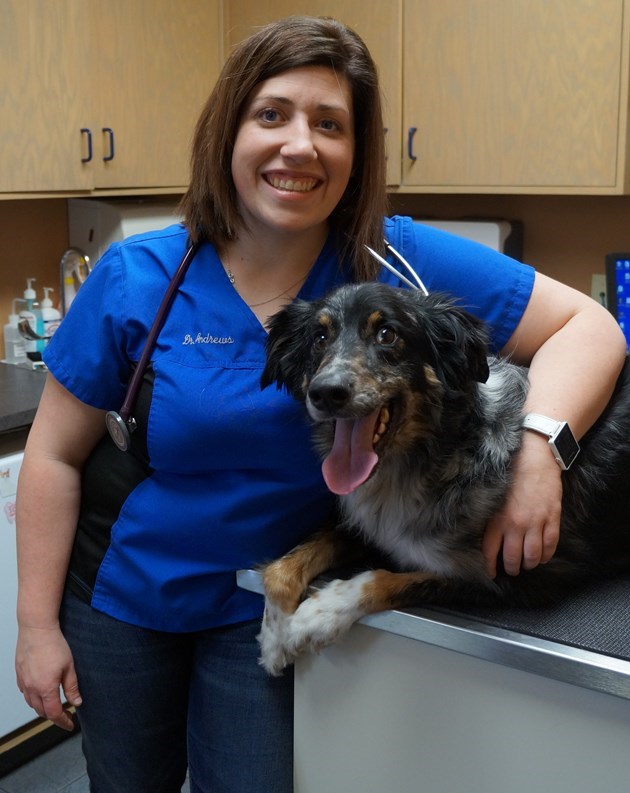There are not many certainties in life, but from November to March in Canada, there is one: it’s cold.
No one can be blamed for wanting to hibernate the entire season away, but if you have a dog, chances are you’re going to be braving the weather – or braving a crazy, bored and begging pup. But while we humans have designed all manner of clothing to protect us from the chill, dogs seem to have been born with everything they need.
Or have they?
According to Dr. Courtney Andrews — ‘Dr. Courtney’ to her furry patients — the answer depends on your dog. An associate veterinarian at Lockerby Animal Hospital, she says, “Any animal that goes outside in winter weather conditions should have considerations for their exposure to the elements, and there are a lot of factors that contribute to what precautions are needed: size, coat thickness, and conditioning for example.”
Helping them stay warm starts with evaluating your pet’s individual needs and lifestyle. Larger dogs tend to have a lower surface area to volume ratio and will, therefore, lose heat at a slower rate than smaller breed dogs. But large, thin dogs – like greyhounds – have a different cold tolerance than thicker dogs, and they’ll require more protection.
Your dog’s breed will be a factor. If you have a dog who is made for winter, you may do a disservice to them by bundling them up.
“For example, German shepherds, huskies, and malamutes are large breed dogs with adaptations to help them be well-insulated for the winter. Putting these dogs in coats or booties could cause them to overheat.”
As well, bear in mind what you and your dog will be doing outside.
“A dog running through the bush or hunting will be more active and be generating heat, while a leisurely walk on a leash is less strenuous and may require more consideration for warmth.”
Consider also your dog’s couch-potato tendencies. If the last time they left the cushion of their own free will was dinner time, their paws may not be as conditioned as needed.
In fact, paw protection can be important for all dogs.
“Quite obviously, dogs walk on their paws,” says Dr. Courtney. “Their skin is directly exposed to everything present on the ground. In the winter, they are exposed to salt and sand used for traction, ice and snow, even antifreeze and windshield washer fluid. This can cause cuts, scratches, and irritations which can lead to infections. Frostbite, though rare, can also occur.”
If you feel you should, protecting their paws comes in three forms: paw protectors, booties, and grooming. For any of them to work though, your pet needs to be comfortable having their paws touched.
“Starting young helps,” says Dr. Courtney. “Massage their paws, play with their toes when they are at home laying down to get them use to the idea and then slowly increase the length of contact and pressure.”
Another method is using ‘booties,’ hard bottom sock-like boots with an upper strap, but if you’ve ever seen a video of dogs wearing these boots, you know they can be a tough sell.
“Booties are probably the hardest thing to get a pet used to. Starting slowly wearing for a few minutes then gradually increasing the time seems to work best, but you will find that every dog is different, some will accept the boots right away while others will never get used to them.”
There are also products available that act as a buffer between their paws and the ground.
“There are some wax-based products, similar to human lip balms, but designed specifically for dog paws.”
It can protect them from chemicals and salt, and when you put it on the fur, it prevents snowballs between their toes.
“Cooking spray has also been suggested, but this will be a little slippery and leave grease on your floors.”
You should also examine the hair around and between the pads of your dog’s paw.
“Medium- and long-coated dogs can have extra fur between their toes that trap snow and form snowballs, keeping the snow and salt combination in contact longer. You may have noticed your dog on walks stopping to chew at their feet to get rid of these.”
If you have noticed this, know that trimming the area is a bit controversial, and you may be best to consult your veterinarian or groomer before attempting.
“While balls of snow can get stuck, this fur can also be insulating against the cold,” says Dr. Courtney. “If you decide to trim the fur on your dogs’ feet on your own be careful. Trimmers are best to prevent accidentally cutting yourself or your dog in the process.”
While it is very important to make sure your dog is as protected as you are from winter’s chilly grip, don’t let it be a reason to keep you, or your dog, inside all winter.
As Dr. Courtney says, “Every dog is different and will have a different cold tolerance, however, any dog can be acclimated to the cold weather with exposure, so don’t let the cold weather keep you enjoying the winter with them!”
Jenny Lamothe is a freelance writer, proof-reader, and editor in Greater Sudbury. Contact her through her website, JennytheWriter.wordpress.com.



